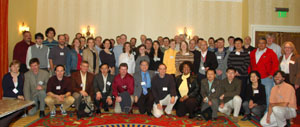SER-CAT gathering advances
collaboration
by Cindy AbolePublic Relations
In early March, researchers and scientists learned about the scope of X-ray crystallography research that is ongoing at MUSC and institutions around the Southeast by attending the Fifth Annual SER-CAT Symposium held at the Charleston Marriott.
The South East Regional Collaborative Access Team (SER-CAT) meeting gathered X-ray crystallographers, structural biologists and researchers interested in new structure research, high-resolution structural analysis, drug design and protein engineering in an effort to draw awareness to research progress and expand capabilities.
“This meeting achieved two very important goals for our growing program in structural biology,” said Christopher Davies, Ph.D., associate professor, Department of Biochemistry and Molecular Biology, and director of MUSC’s Center for Structural Biology. “First, it allowed us to show the strength and breadth of X-ray crystallography research at MUSC to an outside audience comprising some of the top crystallographers in the U.S. Secondly, it will have inspired MUSC investigators by exposing them to some of the most exciting crystal structures being published at the moment. The long-term value of such interactions cannot be overstated.”
 SER-CAT
is a regional collaborative of a 26 member consortium of Southeastern
universities, private industry, the National Aeronautics and Space
Administration and the National Institutes of Health. Established in
1997 by the University of Georgia, the group successfully constructed
two synchrotron beamlines at the Advanced Photon Source, Argonne
National Laboratory in Illinois.
SER-CAT
is a regional collaborative of a 26 member consortium of Southeastern
universities, private industry, the National Aeronautics and Space
Administration and the National Institutes of Health. Established in
1997 by the University of Georgia, the group successfully constructed
two synchrotron beamlines at the Advanced Photon Source, Argonne
National Laboratory in Illinois. Participants attended speaking sessions, workshops and a scientific poster session. The meeting included talks by the winners of the 2008 SER-CAT Young Investigator Award and the Outstanding Science Award, and a keynote talk by John Sondek, Ph.D., professor of pharmacology, University of North Carolina at Chapel Hill. One notable attendee was former NASA astronaut Larry DeLucas, Ph.D., professor of Optometry, University of Alabama at Birmingham, who flew aboard the Space Shuttle (STS-50) and is a pioneer of efforts to crystallize proteins under the conditions of zero gravity.
“It was a great honor for MUSC to host this group and an opportunity to meet Chris’ colleagues, who are among the country’s top experts in X-ray crystallography and structural biology. Much congratulation goes to Chris and his team for coordinating this event, and there have been many key people who’ve been instrumental in establishing the campus’ structural biology infrastructure. Structural biology research is an area of focus on campus and an important underpinning of our developing programs in drug discovery,” said Stephen M. Lanier, Ph.D., associate provost for research at MUSC.
Biochemistry and Molecular Biology chair, Yusuf Hannun, M.D., Ralph F. Hirschmann Professor, also praised MUSC’s support of this meeting.
“Structural biology is at the heart of modern biomedical research as it deciphers the structure and consequently the functions of the molecules of life at an unprecedented atomic detail,” said Hannun. “This is of great importance for understanding physiology, pathology, and for drug development. MUSC has had a decade-long strategic plan to develop structural biology with special emphasis on crystallography and NMR (nuclear magnetic resonance) spectroscopy. Dr. Davies is our lead crystallographer and a structural biologist. He organized an unprecedented symposium dedicated to structural biology.”
X-ray crystallography uses highly intense X-rays to determine 3-D structures of macromolecules, such as proteins, DNA, RNA, or protein-DNA/RNA complexes. Synchrotron radiation is used to determine such structures by a method known as multiwavelength anomalous dispersion (MAD) and it also reveals the molecules at a greater level of detail.
The event ended with a scientific poster session and reception at the South Carolina Aquarium. The event was cosponsored by MUSC’s Center for Structural Biology, Qiagen, Rigaku, South Carolina Experimental Program to Stimulate Competitive Research & Institutional Development Awards Program, and MUSC Office of Academic Affairs and Provost.
“The success of this symposium speaks volumes as the developing stature of structural biology at MUSC, and we are proud of the accomplishments of Dr. Davies as well as his colleagues in structural biology, especially Drs. Mirko Hennig and Jeff Hansen. The symposium was a large success with attendees from all over the Southeast as well as beyond,” Hannun said.
Friday, April 4, 2008
Catalyst Online is published weekly,
updated
as needed and improved from time to time by the MUSC Office of Public
Relations
for the faculty, employees and students of the Medical University of
South
Carolina. Catalyst Online editor, Kim Draughn, can be reached at
792-4107
or by email, catalyst@musc.edu. Editorial copy can be submitted to
Catalyst
Online and to The Catalyst in print by fax, 792-6723, or by email to
catalyst@musc.edu. To place an ad in The Catalyst hardcopy, call Island
Publications at 849-1778, ext. 201.